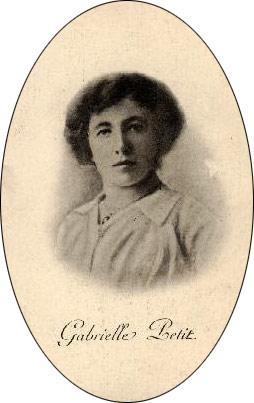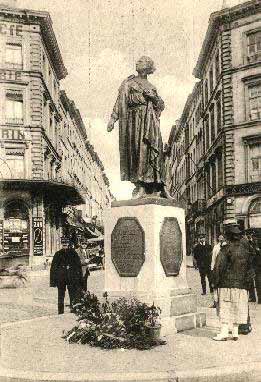Gabrielle Petit

Sentenced to death by the Germans in 1916 for espionage, the distribution of clandestine press and participation in the extraction of soldiers, Gabrielle Petit, “Gaby”, is an iconic figure in the history of the contribution of Belgian women during the First World War.
Gabrielle Aline Eugénie Marie Petit was born to working class parents in Tournai, Belgium. She was raised in a Catholic boarding school from the age of five following her mother's death. Gabrielle and her sister Hélène were placed with the Dames du Sacré Coeur, in Mons, abandoned by their father. The young girls were then collected by a cousin who sent them to live with the Soeurs de l’Enfant Jésus in Brugelette, where the two young girls finally found the intellectual and emotional fulfilment required. At 17, Gabrielle was ordered by her father to return home. The difficult living arrangement came to end after several months. The young women decided to move to Brussels where Hélène found work as a governess for a Mrs. Butin.
At the outbreak of war, Gabrielle Petit was 21 years old. She was engaged to a professional soldier, Maurice Gobert, who she’d met two years earlier. He was injured in Hofstade (near Liège). Captured by the Germans, he escaped and rejoined Gaby who then reached the front by joining the Red Cross in Molenbeeck-Saint-Jean. The couple, cut off from the Belgian army, were forced to hide in their attempt to cross the Dutch border.
When she returned to Belgium, she enlisted with the intelligence services. She was trained in England, in July 1915, and quickly made a name as an active spy. Now called Mrs. Legrand, she worked in the Ypres sector in Maubeuge, living among enemy troops, assuming many false identities, collecting information on the movements of German troops, strategic points, armament conditions and the rail network on behalf of the Allies. She was also responsible for distributing a clandestine newspaper (La Libre Belgique), assisted an underground mail service to captive soldiers and helping soldiers imprisoned behind German lines cross the Dutch border.
However, in autumn 1915 the German counter-espionage services stepped up their operations. Gabrielle Petit, who had already raised suspicions several months earlier, was placed under surveillance. She managed to escape from her pursuers a first time through the narrow streets of Molenbeek. Arrested in Hasselt, she escaped from the hostel where she was being detained. The vice tightened in December. The German secret services arrested and replaced the mailman in her network by a Dutch traitor who delivered the messages to the Kommandantur for over a month. Trusting no-one, Gaby left absolutely no clue that would allow anyone to identify the members of her team.
She was arrested on 20 January 1916 by police officer Goldschmidt and secretly detained for five days at the Kommandantur. Neither her interrogator nor a destructive search of her apartment unearthed any proof. The prisoner was then transferred to Saint-Gilles Prison in Brussels on 2 February. There, resisting harsh interrogations and conditions at the prison, she proved the innocence of the family of her landlady, Mrs Collet, and put in place a system for imprisoners to receive supplies and communications. She refused to betray her fellow agents despite offers of amnesty.
Gabrielle Petit was sentenced to death on 3 March 1916. On 8 March her sister made a plea for clemency, written by Mr. Marin, director of the Saint-Gilles Prison and backed by the Apolistic Nunciature and Legation of Spain, to the Kommandatur which refused to repeal its decision. On 1 April, the sentence was carried out by the firing squad in Schaarbeek. Her body is buried there at the execution field. Her story not attracting the notoriety of Louise de Brettignies or Edith Cavell, her execution remained unknown to the public until 1919 when she received her just honours at a national ceremony presided over by Queen Elisabeth of Belgium, Cardinal Mercier and the Prime Minister Delacroix. On 27 May, her body was exhumed and displayed for two days in the Salle des Pas-Perdus of the municipal hall before being buried in the cemetery in the town of Schaarbeek.
A statue was dedicated to her in Brussels and a square named after her in Tournai.

Statue de Gabrielle Petit à Bruxelles. Source : www.ww1-propaganda-cards.com

